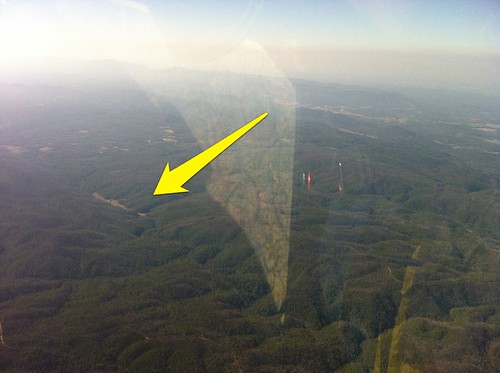FastEddieB
Touchdown! Greaser!
- Joined
- Oct 14, 2013
- Messages
- 11,421
- Location
- Lenoir City, TN/Mineral Bluff, GA
- Display Name
Display name:
Fast Eddie B
Re: 45th Cirrus CAPS (Parachute) activation in Aus and the best footage caught to dat
I routinely fly from Copperhill, TN to Knoxville. Did so yesterday as a matter of fact so Karen could be with a sick friend.
Even angling over towards Tellico Plains (in the distance below), there's a stretch where landing options are few and far between or well nigh nonexistent:

The arrow marks the one spot I might be able to make if my engine fails. With a 39k stall speed, I may be OK even going into trees, but my Sky Arrow's pusher configuration leaves me with not much structure in front of me. BTW, that type of terrain is very common in the Southern Appalachians.
I owned a Cirrus from 2003 to 2007. I did not buy it because of the chute. But like many safety features, once its there you kind of get used to the comfort it brings. My Sky Arrow has no chute - I would add one if I could get some extra gross weight allowance, but I don't see that happening and not sure if its even feasible with the airframe as it is.
BTW, I agree that 8 engine outs is an interesting hair raise
hair raise number. I've had one in almost 40 years of flying, and that was right after takeoff with runway remaining. To have 8 really should have an explanation.
number. I've had one in almost 40 years of flying, and that was right after takeoff with runway remaining. To have 8 really should have an explanation.
As an aside, the Cirrus engine out in the Bahamas was a doctor who does God's work taking care of patients in Haiti, using his Cirrus to ferry medical supplies as well as himself. So the chute's value in this case went far beyond just saving his and his daughter's lives.
Over what sort of terrain/landscape?
I routinely fly from Copperhill, TN to Knoxville. Did so yesterday as a matter of fact so Karen could be with a sick friend.
Even angling over towards Tellico Plains (in the distance below), there's a stretch where landing options are few and far between or well nigh nonexistent:

The arrow marks the one spot I might be able to make if my engine fails. With a 39k stall speed, I may be OK even going into trees, but my Sky Arrow's pusher configuration leaves me with not much structure in front of me. BTW, that type of terrain is very common in the Southern Appalachians.
I owned a Cirrus from 2003 to 2007. I did not buy it because of the chute. But like many safety features, once its there you kind of get used to the comfort it brings. My Sky Arrow has no chute - I would add one if I could get some extra gross weight allowance, but I don't see that happening and not sure if its even feasible with the airframe as it is.
BTW, I agree that 8 engine outs is an interesting
As an aside, the Cirrus engine out in the Bahamas was a doctor who does God's work taking care of patients in Haiti, using his Cirrus to ferry medical supplies as well as himself. So the chute's value in this case went far beyond just saving his and his daughter's lives.


 Got a reference?
Got a reference?
